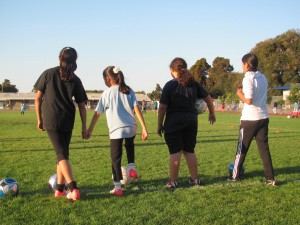Hear more about this story and how it developed on the Peninsula Report radio podcast.

Ravenswood City School District will revisit recent fee hikes for youth sports programs, whose leaders say their ability to operate has been jeopardized by thousands of dollars in extra expenses.
At its Sept. 27 meeting, the Ravenswood school board temporarily reinstated reduced rental rates for athletic fields while it discusses how much to charge outside organizations for use of East Palo Alto school facilities.
Since 2006, the youth sports programs have paid a reduced “Group 1A” rate of $5 per child to rent facilities for a 12-week season. But in May, the board eliminated that exception, requiring groups to instead pay by the hour, day or week. The decision sparked criticism from the athletic programs and their supporters, with more than 100 people showing up at a special board meeting two weeks ago to complain about the higher fees.
“Over the last two years, we’ve suffered tremendous losses due to state budget cuts,” board Vice President Sharifa Wilson said in an interview following the Sept. 27 vote. “We’re trying to avoid affecting classrooms.”
Renting facilities at discounted rates was costing the Ravenswood district, Wilson said, and it could no longer afford to subsidize the wear and tear caused by outside groups.
Wilson acknowledged that the higher rates created a financial hardship for the youth sports programs. She said reinstating the Group 1A policy was “a gesture” to show community members that the board is interested in working with them to find a solution.
The board’s action did not satisfy Shannon Pekary, founder of Ravenswood Youth Athletic Association. Pekary has spearheaded the effort to overturn the hourly fee schedule, which runs from $25 for a field to $100 for the Costaño Elementary school gym, calling it “unworkable” for nonprofit organizations in the area.
At the Sept. 27 meeting, Pekary asked the school board to address what he believes are two oversights in its resolution—by making the temporary reinstatement of Group 1A retroactive and including gyms in the policy. Though historically the district has charged the reduced rates for use of school gyms, they are not explicitly included in the written code.
The board did not approve his request, which Pekary said will adversely affect teams that were charged the higher rates over the summer, as well as upcoming winter sports like basketball and his own indoor soccer program.
Pekary said he is facing a spike in gym rental fees from $900 per season for about 150 kids to more than $18,000 for the space and related expenses, an additional cost that will probably be passed on to the players.
“There was a sense that by charging $5 a player, organizations like ours could budget more easily,” Pekary said. “If we add kids, we’re just adding more expense.”
As both sides grapple with limited resources, a fundamental disagreement has emerged over what the youth sports programs owe Ravenswood to use its facilities.
In a presentation at a Sept. 20 meeting, district business manager Megan Curtis said the regular hourly rates were set using state guidelines set for renting school property to outside groups. Under the guidelines, organizations are charged only the “direct cost” to the district, including supplies, utilities and janitorial services.
Pekary disputed that notion. Based on the calculations presented by Curtis, he believes groups such as his are being held responsible for more than their fair share of maintenance expenses.
“I am all for recouping the district’s costs to us,” he said. But “we’re not on a hook for all of the district’s costs to maintain the field. They’re supposed to maintain the field for their own kids.”
Pekary cited a table from Curtis’ PowerPoint slideshow, in which all costs to maintain athletic fields during the 2011-12 fiscal year were divided by week and location to determine a fee schedule. Curtis concluded that each field cost about $5,600 per 12-week season to maintain; under the new system, organizations would be charged $3,000 to rent for that same period.
Board member Wilson said school officials would now look beyond the district’s general fund for ways to cover the cost of maintaining facilities for community use, including getting financial support from East Palo Alto’s Measure C and Transient Occupancy Tax (TOT).
Measure C is a parcel tax that supports violence-prevention efforts in the community. TOT is a tax on hotel guests, 10 percent of which is dedicated to child, family and senior services. Both provided $100,000 in grants for summer youth programs this year, according to the city of East Palo Alto.
“The bottom line is that we will find the money,” Wilson said.
